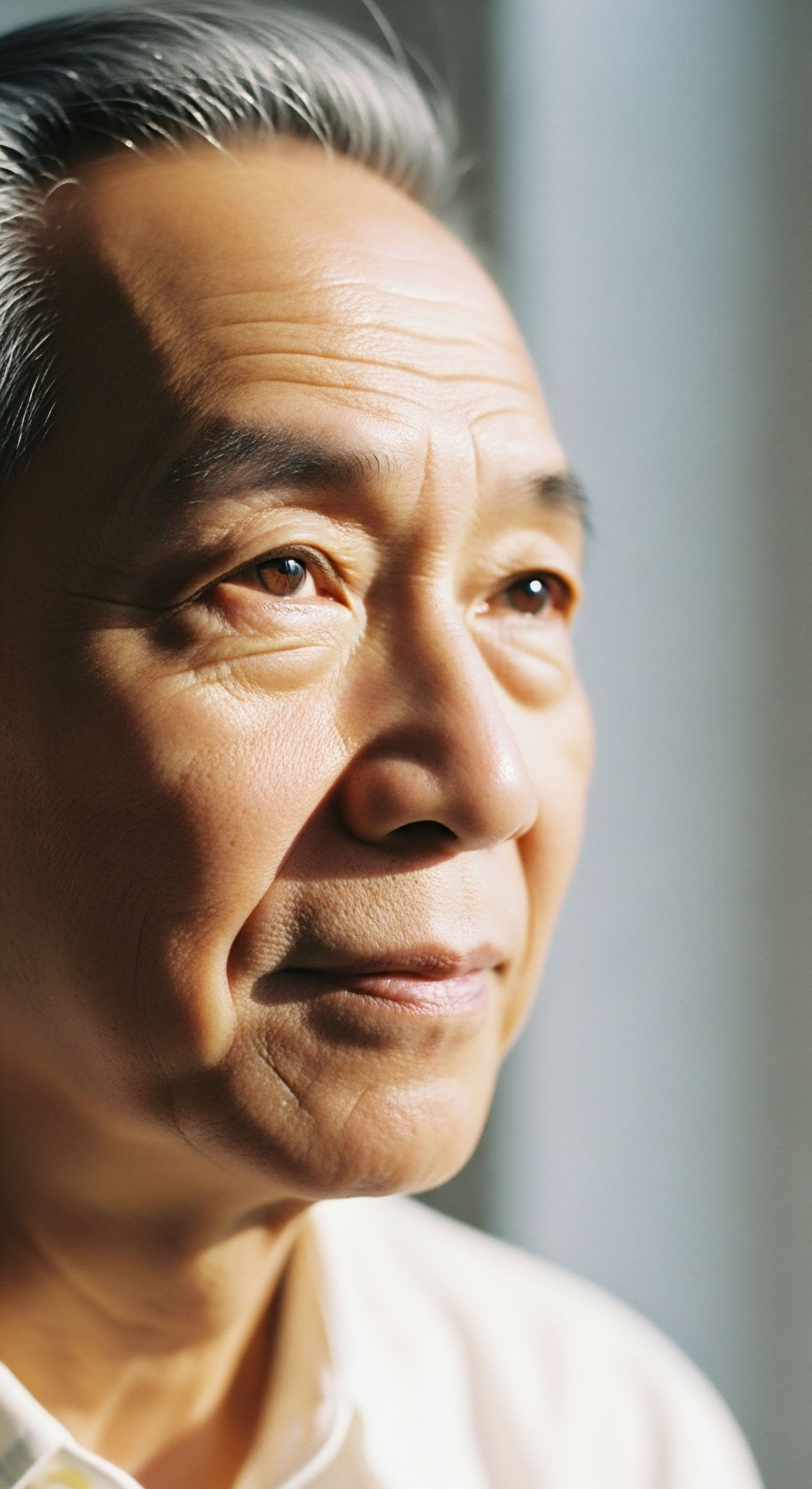

Fundamentals
You feel it long before a lab test gives it a name. The persistent fatigue that sleep does not resolve, the mental fog that clouds focus, and a subtle but definite withdrawal from the life you once engaged with fully. These experiences are real, and they are valid.
They are signals from your body’s intricate internal communication network, the endocrine system. When we explore the question of restoring hormonal balance, we are truly asking how to recalibrate the very system that governs energy, mood, and vitality. The journey begins with understanding the control center itself.
At the heart of male hormonal health lies a sophisticated feedback loop known as the Hypothalamic-Pituitary-Gonadal (HPG) axis. Think of it as your body’s internal thermostat for testosterone production. The hypothalamus, a small region in your brain, senses the body’s needs and sends a signal ∞ Gonadotropin-Releasing Hormone (GnRH) ∞ to the pituitary gland.
The pituitary, in turn, releases Luteinizing Hormone (LH) and Follicle-Stimulating Hormone (FSH) into the bloodstream. These hormones travel to the testes, instructing them to produce testosterone and sperm. When testosterone levels are sufficient, they send a signal back to the hypothalamus and pituitary to slow down production, maintaining a precise balance. This entire system is designed for elegant self-regulation.
A clinical diagnosis of hypogonadism identifies a disruption in the body’s natural testosterone production, but the origin of that disruption is the critical factor in determining a path to restoration.
A diagnosis of clinically diagnosed hypogonadism means this finely tuned system is faltering. The critical next step is to understand where the disruption originates. This is where the distinction between different types of hypogonadism becomes paramount, as it dictates the potential for lifestyle interventions to be effective.

Understanding the Types of Hypogonadism
There are two primary classifications for this condition, each with profoundly different implications for recovery. A third, functional category is emerging as a central concern in modern health.
- Primary Hypogonadism This condition involves a fundamental issue with the testes themselves. They are unable to produce sufficient testosterone despite receiving the correct signals from the brain. This can be due to genetic conditions like Klinefelter syndrome, physical injury, or damage from treatments like chemotherapy or radiation. In this scenario, the HPG axis is sending the right messages, but the receiving equipment is damaged. Lifestyle interventions can support overall health, but they cannot repair the underlying structural or genetic problem.
- Secondary Hypogonadism Here, the testes are perfectly capable of producing testosterone, but the issue lies upstream in the brain. The hypothalamus or pituitary gland fails to send the necessary signals (GnRH and LH) to initiate production. This can be caused by tumors, inflammatory diseases, or genetic disorders affecting the pituitary or hypothalamus. Similar to primary hypogonadism, this form often involves structural or organic issues that lifestyle changes alone cannot resolve.
- Functional Secondary Hypogonadism This is a distinct and increasingly common form of secondary hypogonadism. In this case, the entire HPG axis ∞ hypothalamus, pituitary, and testes ∞ is structurally sound and healthy. The suppression of hormonal signals comes from external pressures and systemic metabolic stress. Factors like obesity, insulin resistance, chronic inflammation, poor sleep, and high psychological stress can dampen the signaling from the hypothalamus, effectively turning down the thermostat. This is a state of suppression, a protective downregulation by the body in response to systemic imbalance. It is this functional form of hypogonadism that is most amenable to reversal through profound lifestyle modifications.
Therefore, the effectiveness of lifestyle interventions hinges entirely on the correct diagnosis. For men with functional secondary hypogonadism, which is frequently linked to obesity and metabolic syndrome, these interventions are the primary and most powerful therapeutic tool. They address the root cause of the hormonal suppression.
For men with organic primary or secondary hypogonadism, lifestyle changes serve as a vital supportive measure to optimize the effects of necessary medical treatments, such as hormone replacement therapy, by improving overall metabolic health and well-being.


Intermediate
Understanding that functional hypogonadism is a state of suppression rather than permanent damage opens a direct pathway for intervention. The body’s hormonal signaling has been downregulated by metabolic stress, and the logical path to restoration is to remove that stress. This is achieved through a coordinated strategy involving nutrition, targeted physical activity, and restorative sleep.
Each of these pillars directly influences the HPG axis, providing the raw materials for hormone synthesis, improving insulin sensitivity, and reducing the inflammatory signals that interfere with testosterone production.

Dietary Architecture for Hormonal Recalibration
The food you consume provides the fundamental building blocks for every hormone in your body. A diet designed to restore hormonal balance focuses on nutrient density and metabolic efficiency. It supplies the necessary precursors for testosterone production while simultaneously reducing the metabolic dysfunction that suppresses it.

Macronutrients the Foundational Substrates
Macronutrients ∞ protein, fats, and carbohydrates ∞ are the architectural components of your endocrine health. Their balance is critical for optimizing the HPG axis.
- Dietary Fats Cholesterol, often misunderstood, is the direct molecular precursor to all steroid hormones, including testosterone. A diet severely deficient in healthy fats can limit the raw materials available for hormone synthesis. Sources like avocados, olive oil, nuts, seeds, and fatty fish provide both the necessary cholesterol backbone and essential fatty acids that support cellular health and reduce inflammation.
- Proteins Adequate protein intake is essential for maintaining muscle mass, which is a key metabolic organ. Improved muscle mass enhances insulin sensitivity, a crucial factor in reversing functional hypogonadism. Protein also provides the amino acids necessary for producing signaling molecules and enzymes involved in the endocrine system.
- Carbohydrates Carbohydrates play a nuanced role. While excessive intake of refined carbohydrates can drive insulin resistance and inflammation, appropriately timed and sourced carbohydrates can support testosterone production. They help replenish glycogen stores after exercise and can lower levels of cortisol, a stress hormone that has an inverse relationship with testosterone. The focus should be on complex, fiber-rich sources like vegetables, legumes, and whole grains.

Micronutrients the Essential Catalysts
If macronutrients are the building blocks, micronutrients are the specialized tools and catalysts required for construction. Several vitamins and minerals are directly involved in the testosterone production pathway.
| Micronutrient | Role in Hormonal Health | Primary Dietary Sources |
|---|---|---|
| Zinc | Acts as a critical cofactor for enzymes involved in testosterone synthesis. A deficiency has been directly linked to lower testosterone levels. | Oysters, beef, pumpkin seeds, lentils |
| Vitamin D | Functions as a steroid hormone itself and its receptors are found in endocrine tissues, including the testes. Studies show a strong correlation between Vitamin D sufficiency and healthy testosterone levels. | Sunlight exposure, fatty fish (salmon, mackerel), fortified milk, egg yolks |
| Magnesium | Plays a role in modulating the bioavailability of testosterone by influencing Sex Hormone-Binding Globulin (SHBG). It helps increase the amount of free, biologically active testosterone. | Dark leafy greens (spinach, kale), almonds, avocados, dark chocolate |

Exercise Protocols for Endocrine Optimization
Physical activity is a potent modulator of the endocrine system. The right type of exercise sends powerful signals to the body to build muscle, improve insulin sensitivity, and increase testosterone production. The wrong type, particularly chronic, excessive endurance exercise without adequate recovery, can elevate cortisol and suppress the HPG axis.
Targeted exercise, specifically resistance training and high-intensity intervals, acts as a direct stimulus for testosterone production and improves the metabolic environment in which hormones operate.

Resistance Training the Anabolic Signal
Lifting heavy weights, particularly with compound movements that engage large muscle groups (like squats, deadlifts, and presses), is one of the most effective ways to boost testosterone. The mechanical stress on the muscles triggers a cascade of hormonal responses, including an acute increase in testosterone and growth hormone. Over time, the resulting increase in muscle mass improves the body’s ability to handle glucose, reducing insulin resistance and creating a more favorable metabolic environment for the HPG axis to function optimally.

High-Intensity Interval Training (HIIT) the Metabolic Catalyst
HIIT involves short bursts of all-out effort followed by brief recovery periods. This type of training has been shown to be highly effective at improving insulin sensitivity and promoting fat loss, particularly visceral fat, which is a major source of inflammatory signals that disrupt hormone production. HIIT can provide a significant testosterone boost in a shorter amount of time compared to steady-state cardio.

The Non-Negotiable Role of Sleep and Stress Management
The benefits of a perfect diet and exercise plan can be completely undermined by poor sleep and chronic stress. The majority of daily testosterone release occurs during the deep stages of sleep. Consistently failing to get 7-9 hours of quality sleep per night directly impacts morning testosterone levels.
Similarly, chronic psychological or physiological stress leads to elevated cortisol levels. Cortisol is produced from the same precursor molecule as testosterone (pregnenolone) and its overproduction can create a “pregnenolone steal,” limiting the resources available for testosterone synthesis. Furthermore, cortisol directly suppresses signaling at the level of the hypothalamus and pituitary, further inhibiting the HPG axis.


Academic
A comprehensive analysis of functional secondary hypogonadism requires a detailed examination of the molecular and cellular mechanisms that link metabolic dysregulation to the suppression of the Hypothalamic-Pituitary-Gonadal (HPG) axis. The condition is fundamentally a pathophysiological state where an otherwise intact neuroendocrine axis is inhibited by systemic inflammation, insulin resistance, and aberrant signaling from adipose tissue. Understanding these pathways illuminates why lifestyle interventions are not merely beneficial but are the definitive, mechanism-based treatment for this specific diagnosis.

The Pathophysiology of Adipose-Induced HPG Suppression
In lean individuals, adipose tissue functions as a passive energy storage depot and an endocrine organ that participates in healthy metabolic signaling. In the context of obesity, particularly visceral adiposity, this tissue becomes hypertrophic, dysfunctional, and highly inflammatory. This state initiates a cascade of events that directly suppresses HPG axis function at multiple levels.

Adipokines and Inflammatory Cytokines
Dysfunctional adipose tissue secretes a host of signaling molecules, including adipokines and pro-inflammatory cytokines, that have deleterious effects on the central regulation of reproduction.
- Leptin While leptin is typically associated with satiety, in the context of obesity, a state of leptin resistance develops. Chronically elevated leptin levels, combined with this resistance, can disrupt the pulsatile secretion of Gonadotropin-Releasing Hormone (GnRH) from the hypothalamus, which is the master regulator of the HPG axis.
- Inflammatory Cytokines Adipose tissue in obese individuals becomes a major source of pro-inflammatory cytokines such as Tumor Necrosis Factor-alpha (TNF-α) and Interleukin-6 (IL-6). These molecules can cross the blood-brain barrier and induce a state of hypothalamic inflammation. This neuroinflammation directly impairs the function of GnRH neurons, reducing the primary signal for the pituitary to release LH and FSH.
- Aromatase Activity Adipose tissue is a primary site of aromatase expression, the enzyme that converts androgens (testosterone) into estrogens (estradiol). Increased adipose mass leads to accelerated peripheral aromatization of testosterone to estradiol. The resulting higher levels of estradiol exert a potent negative feedback on the hypothalamus and pituitary, further suppressing GnRH and LH secretion and compounding the hypogonadotropic state.

The Role of Insulin Resistance and SHBG
Insulin resistance, a hallmark of metabolic syndrome and obesity, is another critical mechanism in the development of functional hypogonadism. The liver produces Sex Hormone-Binding Globulin (SHBG), a protein that binds to testosterone in the bloodstream, regulating its bioavailability. High levels of circulating insulin directly suppress hepatic SHBG production.
Lower SHBG levels mean that while free testosterone might be transiently maintained, total testosterone levels plummet. This reduction in total testosterone is a key diagnostic marker and reflects a state of significant metabolic distress. Lifestyle interventions, particularly weight loss and exercise, are the most effective methods for improving insulin sensitivity, thereby allowing for the normalization of SHBG production and a subsequent increase in total testosterone concentrations.

Quantifying the Reversibility Evidence from Longitudinal Studies
The concept of reversibility is substantiated by robust clinical evidence. The European Male Ageing Study (EMAS) provided powerful prospective data on this topic. In this large, multi-center observational study, researchers followed a cohort of community-dwelling men for 4.3 years. The study found that obesity was a primary predictor for developing incident secondary hypogonadism.
More importantly, it demonstrated that recovery was common. Of the men who had secondary hypogonadism at baseline, 42.9% recovered to a eugonadal state during the follow-up period. The single most significant predictor of this recovery was weight loss. This provides a clear, quantitative demonstration that for a substantial portion of men with functional secondary hypogonadism, the condition is indeed reversible through lifestyle modification.
| Study/Trial | Intervention | Population | Key Findings |
|---|---|---|---|
| European Male Ageing Study (EMAS) | Observational (Weight Loss) | Community-dwelling men 40-79 years | Obesity predicted development of secondary hypogonadism. Weight loss was the strongest predictor of recovery, with 42.9% of men with secondary hypogonadism returning to eugonadal status. |
| The Look AHEAD Trial | Intensive Lifestyle Intervention (Diet & Exercise) | Overweight/obese men with Type 2 Diabetes | Intervention group achieved significant weight loss and demonstrated a corresponding significant increase in total and free testosterone levels compared to the control group. |
| Meta-Analysis (Corona et al.) | Low-Calorie Diets | Men with obesity | A meta-analysis of 13 studies showed that an average diet-induced weight loss of 9.8% was associated with a significant increase in total testosterone of approximately 2.8 nmol/L. |

The Limitations of Lifestyle Monotherapy in Organic Hypogonadism
It is clinically imperative to recognize the boundaries of lifestyle interventions. For men with a diagnosis of organic hypogonadism, whether primary (e.g. Klinefelter syndrome, testicular trauma) or secondary (e.g. pituitary adenoma), the underlying pathology is a structural or irreversible failure of a component of the HPG axis.
In these cases, lifestyle interventions are a crucial adjunct therapy. They can improve metabolic health, optimize body composition, and enhance the efficacy and safety of Testosterone Replacement Therapy (TRT). They cannot, however, restore the function of a damaged or absent organ system. The therapeutic goal in these situations is different.
It shifts from restoration of endogenous production to the careful and medically supervised exogenous replacement of testosterone to restore physiological levels, alleviate symptoms, and maintain long-term health. A short-term trial of TRT may even be considered in some cases of severe functional hypogonadism to provide the necessary physical and psychological capacity for the patient to engage in the required lifestyle changes, creating a bridge to potential endogenous recovery.

References
- Bhasin, Shalender, et al. “Testosterone Therapy in Men With Hypogonadism ∞ An Endocrine Society Clinical Practice Guideline.” The Journal of Clinical Endocrinology & Metabolism, vol. 103, no. 5, 2018, pp. 1715-1744.
- Whittaker, J. and F. C. W. Wu. “The Role of Diet and Weight Loss in Improving Secondary Hypogonadism in Men with Obesity with or without Type 2 Diabetes Mellitus.” Nutrients, vol. 13, no. 10, 2021, p. 3395.
- Rastrelli, Giulia, et al. “Development of and Recovery from Secondary Hypogonadism in Aging Men ∞ Prospective Results from the EMAS.” The Journal of Clinical Endocrinology & Metabolism, vol. 100, no. 8, 2015, pp. 3172-82.
- Corona, Giovanni, et al. “Treatment of Functional Hypogonadism Besides Pharmacological Substitution.” World Journal of Men’s Health, vol. 35, no. 1, 2017, pp. 1-10.
- Morales, Alvaro, et al. “Diagnosis and management of testosterone deficiency syndrome in men ∞ clinical practice guideline.” CMAJ, vol. 187, no. 18, 2015, pp. 1369-77.
- Riachy, R. et al. “Various Factors May Modulate the Effect of Exercise on Testosterone Levels in Men.” Journal of Functional Morphology and Kinesiology, vol. 5, no. 4, 2020, p. 81.
- Zamir, A. et al. “How Diet and Exercise Impact Testosterone Levels.” One Health Ohio, 2021.

Reflection

What Is Your Body’s True Potential for Balance
The information presented here provides a map of the biological territory of hormonal health. It details the mechanisms, outlines the pathways, and presents the clinical evidence. This knowledge is a powerful tool, shifting the perspective from one of passive suffering to one of active participation in your own well-being.
The data shows that for many, the body possesses a profound capacity to self-correct when the systemic burdens are lifted. This journey of understanding is the first, most critical step. The next step is personal. It involves looking at this map and plotting your own unique coordinates.
How do these systems operate within you? What specific inputs will your body respond to best? This knowledge, paired with personalized guidance from a qualified practitioner, forms the foundation for a protocol designed not just to treat a symptom, but to restore the function of the entire system, allowing you to reclaim the vitality that is your biological birthright.

Glossary

endocrine system

testosterone production

gnrh

luteinizing hormone

testosterone levels

lifestyle interventions

hpg axis

secondary hypogonadism

lifestyle changes

functional secondary hypogonadism

insulin resistance

with functional secondary hypogonadism

metabolic syndrome

functional hypogonadism

improving insulin sensitivity

insulin sensitivity

adipose tissue

aromatase

sex hormone-binding globulin

total testosterone

weight loss

european male ageing study




